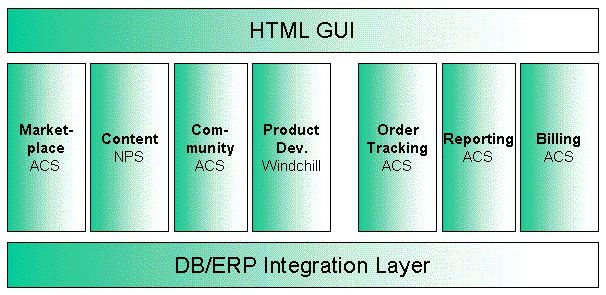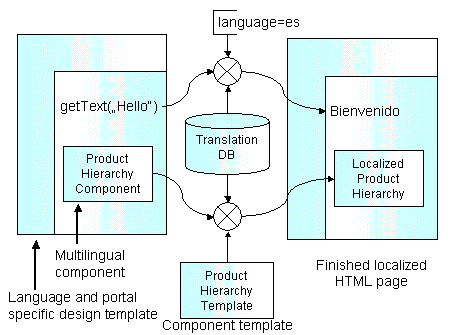B2B Marketplace Multilingual Architecture
Overall Architecture
Figure 1 below shows the schematic architecture of the B2B Marketplace.

Figure 1: Schematic View of the B2B Marketplace
Architecture
This architecture has been developed as a function of the necessities
of the B2B Domain:
- International B2B Domain:
The website serves as an online application rather then as a marketing
device. The clients are located in several countries, so that
contents and transactions have to be presented in several languages
syncronously. The GUI appearence has to be more functional and
cost efficient than experience oriented.
- Translation Workflow:
Content such as news is changing frequently, so that comfortable
maintenance and translation procedures were important. We decided
to use a content management system (Infopark NPS) to implement
the multilingual workflow for all static contents (web pages).
- Language and Portal Specific Configuration:
Apart from running in several languages simultaneously, the application
has to serve several protals at the same time. This way "horizontal"
transactions are possible, selling for example white DIN A4 paper
across several industries.
- Date, Time and Currency:
Date, time and currency were not an issue of this application,
because all clients are located in the same timezone in Europe
(with the same time and date preferences). Also, we chose the
Euro as the single common currency.
- Localization Fallback Handling:
The marketplace implements a simple fallback workflow by sending
Email messages to an administrator in the case of missing translations.
Multilingual Architecture Details
Figure 2 below shows the simplified multilingual flow for the B2B
Marketplace.

Figure 2: Schematic B2B Marketplace Class Diagram
Please note the different types of templates for HTML pages and
for "components" (reusable pieces of code). The content
of HTML pages is translated using explicit calls to the Translation-DB,
while the design templates (which also contain localizable items)
are chosen as a function of language and portal.
Static HTML pages such as news or site information are handled
outside Figure 2 by the NPS content management system which implements
its own translation workflow. Also, the page and component templates
are handled this way.
Please contact us if
you have doubts or questions.
|

